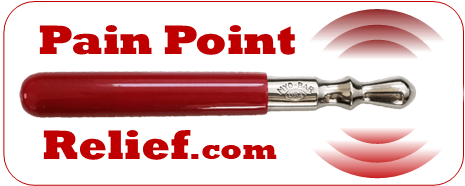Clinical Rationale & Referral Cards
Make patients/clients happy with sound self-care recommendations
All soft tissue therapy, improves function via simple mechanical friction which builds heat and an piezoelectric effect that softens the ground substance, thus allowing normal "glide" between layers of myofascia, and by extension pain free movement. Specific or focused application of mechanical forces by a stainless steel point tool achieves much more efficient localization to problem areas. In the case of self-care the patients own "sense" of discomfort and movement impairment can help them target the causative tissues.
The other "missing link" for myofascial pain recovery is sensible movement and coordination exercise. The Thera-Bo Dynamic Stability Routine requires a $4 dowel rod from Home Depot. In less than 20 minutes the routine integrates rehabilitation of core movement centers in the neck, scapula/shoulder, low back, hip and ankle.
*Request a pack of business-card sized "Referral Cards" to direct patients with myofascial pain to this website for self-care programs. This is the perfect conservative self care for the interim between specialist referrals which can often take several weeks. Why not find out if several weeks of movement and soft tissue therapy improve your patients myofascial conditions? All recommendations on this website are complementary to medical and physical therapy treatments- see below to request a pack of referral cards sent to your office.
Thera-Bo Rationale
The simple Bo-Staff inspired physical therapy aide is helpful in these ways:
- Spinal Over-pressure- popularized by Robin Mackenzie, MD, over-pressure allows end-range joint mobilization which resets mechanoreceptors and gives the CNS "extents" to which movement is programmed within acceptable limits.
- Postural Correction- During the spinal and upper body movements, the staff is held behind the back to achieve automatic neutral cervical spine, scapula, and shoulder. The first half of the routine is done in the ideal "Brugger's" postural alignment. Passively and actively achieving this position for several minutes a day reverses postural decline.
- Balance & Proprioception- The Thera-Bo Staff allows "two-point" balance (something to hold on to) when performing single leg core movements for for the hip and ankle. These are some of the most overlooked and easy preventative fall exercises available.
- Dynamic Stability- All movements are done standing to allow the force of gravity to flow through the entire kinetic chain and to challenge balance. Unlike closed-chain circuit machines, standing dynamic movement models real life.
- Movement Patterning- reaching, squat lift, golfers lift, shoveling, are integrated into the routine to patterns of the most important ergonomic activities of daily living.
- Patient Compliance- These exercises are meant to be done at home, once a day. No driving, changing, gym memberships, etc. While other activities are encouraged, patient compliance with a simple, short home-based routine is much improved.
Trigger Point Tool Rationale
Soft tissue evaluation is a blind spot in health care. Part of the issue is organ system specialization, and the other is lack of diagnostic criteria via exam or imaging for pain syndromes. After years of debate on the existence of of "Trigger Points," it was finally discovered that the famed lesions were mechanical in nature, found not in the muscle bellies, but in the layers of fascia between muscles, nerve channels, and tendon sheaths. Hypoxia, repetitive strain, and/or traumatic injury activate the bodies protective stability mechanism, which in the facial planes is carried out by "densification" of the ground substance. See the Scientific Resources page for more info.
The Trigger Point Tool myofasical self-care aide is helpful in these ways:
- Hand saver- vs. working with the thumbs, the Trigger Point Tool's non-slip red grip make it easy to hold and maneuver into the tissues. As a force multiplier, it requires less effort to release tissues than by using the hands alone.
- Pain Point Finder- Polished Stainless Steel exhibits a property called "diagnostic resonance" where tissue topography under the skin is amplified. This makes it easier to find the Pain Points and Dense Points that indicate restrictive interfascial layers.
- Ease of Use- The Trigger Point Tool is always at hand and can be utilized at work or home. Simple localized self-treatments take only minutes.
- Patient Empowering- after a short learning curve, it becomes easy for individuals to evaluate and manage basic myofascial pain syndromes. This supports your primary treatment and fitness goals.
Program Referral Cards (USA and Canada)
Empower your patient with a complementary self-care regimen. Simply circle the condition on the referral card to direct your patient to the easy tutorial videos on the Pain Syndromes pages of the www.PainPointRelief.com website. Myofascial Self-Care is:
- Complementary- they serve to potentiate medical management, physical therapy, massage, or athletic training modalities that you already recommend.
- Inexpensive- with shipping, the DIY Thera-Bo Kit, Trigger Point Tool, & Myofascial Repair Oil cost $39US (less than some co-pays or a bottle of premium supplements).
- Safe- the only side effect is muscle soreness from over enthusiastic application which we try to discourage in our tutorial videos, or the rare dermal reaction to the myofascial oil (in which case, a hypoallergenic alternative can be used).
- Effective- Simple, easy to follow self care empowers patients to actively participate in their healing process. Focused myofascial therapy is a missing link that the father of orthopedic medicine, James Cyriax, MD identified decades ago. The addition of the 20 min Dynamic Stability routine creates strength, coordination, and flexibility in each of the major core functional areas- neck, scapula, rotator cuff, low back, hip, and ankle.
